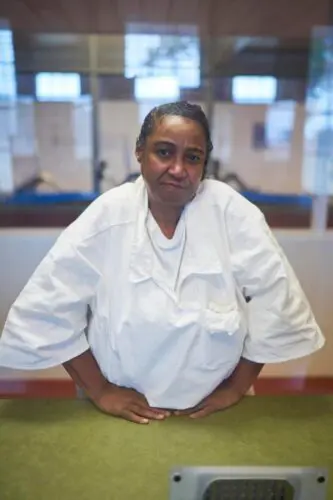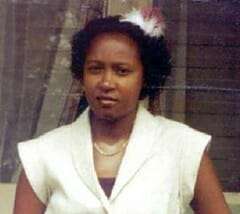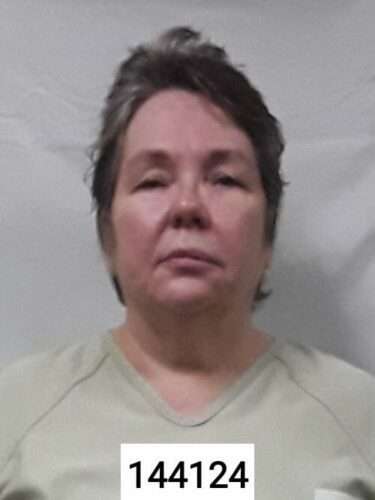
Linda Carty is on death row in Texas convicted of a brutal robbery and murder. Linda Carty and three others would force their way into the home of the victim and proceeded to kidnap her and her three month old child. The mother and child were forced into the trunk of a car with a bag around her head and she would end up dying of suffocation. Linda Carty would be convicted and sentenced to death
Linda Carty 2021 Information

| Name | Linda Carty | |
| TDCJ Number | 999406 | |
| Date of Birth | 10/05/1958 | |
| Date Received | 03/07/2002 | |
| Age (when Received) | 43 | |
| Education Level (Highest Grade Completed) | 1st year of college | |
| Date of Offense | 05/16/2001 | |
| Age (at the time of Offense) | 42 | |
| County | Harris | |
| Race | Black | |
| Gender | Female | |
| Hair Color | Black | |
| Height (in Feet and Inches) | 5′ 3″ | |
| Weight (in Pounds) | 220 | |
| Eye Color | Brown | |
| Native County | St. Chistopher, British Virgin Islands | |
| Native State |
Linda Carty Other News
A Texas judge declined to grant a female British citizen on death row a retrial, which could have changed the outcome of her 2002 capital murder conviction. Lawyers for Linda Carty argued that their client was denied due process when prosecutors did not disclose false witness testimony that painted the defendant as the apparent mastermind of a 2001 murder kidnapping. The Houston Chronicle reported that Carty was sentenced to death after she was convicted of the murder of her neighbour, Joana Rodriguez, in May 2001. Rodriguez was found bound and gagged in the trunk of a car after she and her newborn baby were taken from her Houston home.
After hearing Carty’s appeal, Judge David Garner said prosecutors still had overwhelming evidence of the defendant’s guilt from other sources. Mr Garner agreed that prosecutors should have turned over their witness statements in the 2002 trial, but he ruled that it was not likely have changed the course of Carty’s conviction. These were serious and unfounded allegations of misconduct against two very senior prosecutors who have done nothing for the past two decades except protect and serve people of Harris County. And this recommendation serves to uphold their fine reputations,” Assistant District Attorney Josh Reiss told the Chronicle after the Thursday ruling. Carty – an ex-Drug Enforcement Agency informant born in the Caribbean island of St Kitts when it was under British rule – reportedly led police to the vehicle where Rodriguez was found asphyxiated. The newborn was rescued.
Although, Carty maintains her innocence, prosecutors said she orchestrated the kidnapping with three other men – who did not receive death sentences for their participation in the crime. Prosecutors said that Carty wanted Rodriguez’s newborn son after suffering several miscarriages. Carty was convicted under the Texas “law of parties” which dictates that a person is criminally liable if one “solicits, encourages, directs, aids, or attempts to aid the other person to commit the offence”. Carty worked with three co-conspirators, according to court documents, but was the only of the group to be sentenced to death. Two men testified against her – who later accused prosecutors of coercion – but all three were still convicted and sentenced to time in prison for kidnapping.
Texas is the most active capital punishment state in the US, but as public opinion of the method dwindles, so do execution numbers. The state has, so far, executed six inmates this year, with five more scheduled in 2016. In 2000, the US carried out 85 executions in total – 40 of those occurred in Texas. But in 2015, the state only executed 13 people, according to the Death Penalty Information Centre
Linda Carty More News
The Supreme Court last week turned down an appeal from a British woman sentenced to die for a Harris County murder-kidnapping, moving the case one step closer to a possible execution date.
Linda Carty was sent to death row in 2001 after she was convicted of masterminding a plot to murder her 20-year-old neighbor and steal the woman’s baby in order to save her own common-law marriage.
In the years since the killing of Joana Rodriguez, Carty has consistently professed her innocence, insisting she was railroaded by prosecutors who failed to turn over evidence and coerced witnesses to win a conviction.
Yet the nation’s highest court has now turned down her most recent appeal without comment, refusing to review the argument that the combination of bad lawyering and “egregious prosecutorial misconduct” was enough to make a difference in the outcome of the case.
The now 60-year-old had lived in the Houston area for more than a decade at the time of the slaying, but was born on St. Kitts. At the time, the Caribbean island was a British protectorate, so Carty holds British citizenship – a fact that’s brought her case celebrity attention, spawned a documentary film and landed her on the front pages of papers in the U.K.
During her 2002 trial, prosecutors argued that the former schoolteacher and erstwhile DEA informant had directed three men to storm the victims’ apartment, steal $1,000 and kidnap the mother and her 3-day-old child at gunpoint.
Afterward, authorities found Rodriguez asphyxiated, bound and gagged, in the trunk of a car linked to Carty. Using witness statement, phone records and evidence from cars at the crime scene, Harris County prosecutors persuaded a jury to find her guilty and vote for a death sentence.
For the past 16 years, the now-grandmother has been fighting her conviction.
Carty’s trial was handled by a famously overworked lawyer who never won a death penalty trial, and a federal appeals court decided some of his work on the case was “objectively unreasonable.” But, the court said, it wouldn’t have made a difference in the outcome – even though it was a “close case.”
Later, a Texas state court decided that prosecutors had failed to hand over potentially exculpatory evidence and neglected to reveal information that could have called into question some of the witnesses who testified against her. But, again, the court said it wouldn’t have made a difference in the outcome and wasn’t enough to overcome the evidence against her.
Now in the latest Supreme Court appeal, Carty’s current counsel – a team from Baker Botts led by Michael Goldberg – argued that those things combined would be enough to sway a jury to a different verdict.
And, they said, courts have offered different opinions as to how and when the legal system should handle “cumulative error” claims alleging different types of Constitutional violations all at once.
The National Association of Criminal Defense Lawyers, a group of criminal justice experts including Democratic state Rep. Gene Wu, and the United Kingdom all filed briefs supporting Carty’s appeal.
Now, after the Supreme Court’s rejection, Goldberg says he plans to file another appeal.
Linda Carty Videos
Frequently Asked Questions
Linda Carty Photos


Linda Carty FAQ
Linda Carty 2021
Linda Carty is currently incarcerated on Texas Death Row for Women
Why Is Linda Carty On Death Row
Linda Carty was convicted of a brutal robbery and murder

















